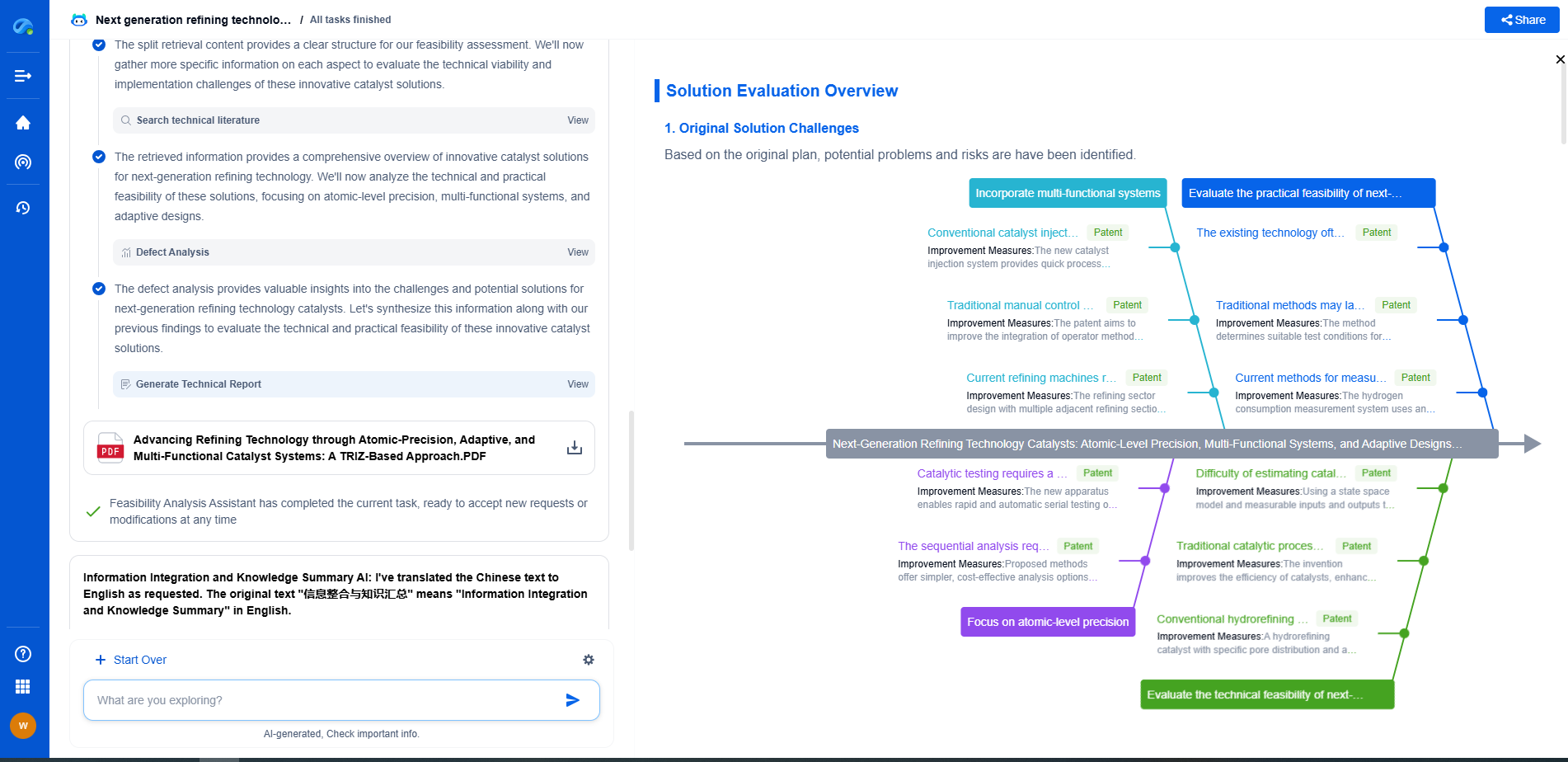Best Electrolyte Materials for High-Performance Lithium Batteries
JUN 20, 2025 |
Understanding Electrolytes in Lithium Batteries
Electrolytes in lithium batteries serve as the medium through which lithium ions move between the anode and cathode during charging and discharging cycles. A good electrolyte ensures efficient ion transport, high ionic conductivity, and stability across a wide range of temperatures and voltages. The performance of the electrolyte is essential for the overall efficiency and safety of the battery. Consequently, extensive research has been conducted to identify and develop electrolyte materials that meet these demanding criteria.
Liquid Electrolytes: Tradition Meets Innovation
Traditionally, liquid electrolytes have been the go-to choice for lithium-ion batteries. They typically comprise lithium salts dissolved in organic solvents. The most commonly used lithium salt is lithium hexafluorophosphate (LiPF6), which is favored for its excellent ionic conductivity and stability. The organic solvents usually include a combination of ethylene carbonate (EC), dimethyl carbonate (DMC), and others that optimize the electrolyte’s properties.
However, conventional liquid electrolytes face challenges such as flammability, leakage, and limited electrochemical stability. To address these issues, researchers are developing advanced liquid electrolyte formulations. For instance, the incorporation of flame-retardant solvents and additives can enhance safety and stability, making them more suitable for high-performance applications.
Solid-State Electrolytes: A Promising Frontier
Solid-state electrolytes represent the next frontier in lithium battery technology. They offer significant advantages over their liquid counterparts, such as improved safety due to their non-flammable nature, and the potential for higher energy densities. There are two main types of solid-state electrolytes: inorganic and polymer-based.
Inorganic Solid Electrolytes
Inorganic solid electrolytes, such as garnet-type oxides (e.g., Li7La3Zr2O12), sulfides, and phosphates, are notable for their high ionic conductivity and stability. Garnet-type electrolytes, in particular, have garnered attention due to their compatibility with lithium metal anodes, which can significantly increase battery capacity. However, challenges remain in the form of high interfacial resistance and mechanical rigidity, which researchers are actively working to overcome.
Polymer-Based Electrolytes
Polymer-based electrolytes, which include polyethylene oxide (PEO) and its derivatives, offer flexibility and ease of processing. They are particularly attractive for flexible and wearable electronics. While their ionic conductivity is generally lower than inorganic options, advancements in polymer chemistry and the incorporation of ceramic fillers are improving their performance. Solutions such as block copolymers and composite electrolytes are being explored to enhance conductivity and mechanical strength.
Ionic Liquid Electrolytes: The Room-Temperature Solution
Ionic liquids are salts that remain liquid at room temperature and have emerged as promising electrolyte candidates due to their unique properties. They are non-volatile, non-flammable, and possess high thermal and electrochemical stability. These characteristics make them particularly appealing for high-performance and safe battery applications.
The challenge with ionic liquid electrolytes has been their relatively high viscosity and lower ionic conductivity compared to conventional liquid electrolytes. Progress is being made by designing ionic liquids with optimized structures, and by blending them with other materials to create hybrid electrolytes that offer the best of both worlds.
Future Perspectives and Innovations
As the demand for higher performance, safer, and more sustainable batteries continues to grow, the quest for the ideal electrolyte material intensifies. Innovations such as hybrid electrolytes, which combine the benefits of different electrolyte types, and the use of artificial intelligence to design novel materials, are on the horizon.
Furthermore, advancements in manufacturing techniques and nanotechnology are expected to play pivotal roles in overcoming current limitations. These developments could lead to breakthroughs in energy density, charging speed, and battery lifespan, ultimately revolutionizing the way we store and use energy.
Conclusion
The choice of electrolyte material is a critical factor in the development of high-performance lithium batteries. While traditional liquid electrolytes remain in use, the rise of solid-state and ionic liquid electrolytes offers exciting possibilities for the future. As research and technology continue to advance, we can anticipate significant improvements in battery performance, safety, and sustainability, paving the way for a new era in energy storage solutions.
Accelerate Breakthroughs in Fuel Cell and Battery Innovation—with the Power of AI
From solid-state battery breakthroughs to high-efficiency hydrogen fuel cells, keeping pace with fast-evolving chemistries, global patent landscapes, and emerging application pathways is an ever-growing challenge for R&D and IP professionals.
Patsnap Eureka, our intelligent AI assistant built for R&D professionals in high-tech sectors, empowers you with real-time expert-level analysis, technology roadmap exploration, and strategic mapping of core patents—all within a seamless, user-friendly interface.
Whether you're optimizing cathode formulations, evaluating electrolyte stability, or navigating the crowded patent space around battery pack design, Eureka empowers you to move faster and with greater confidence.
Start your journey with Patsnap Eureka today—streamline your research, enhance decision-making, and power the future of energy with AI-driven clarity.
- R&D
- Intellectual Property
- Life Sciences
- Materials
- Tech Scout
- Unparalleled Data Quality
- Higher Quality Content
- 60% Fewer Hallucinations
Browse by: Latest US Patents, China's latest patents, Technical Efficacy Thesaurus, Application Domain, Technology Topic, Popular Technical Reports.
© 2025 PatSnap. All rights reserved.Legal|Privacy policy|Modern Slavery Act Transparency Statement|Sitemap|About US| Contact US: help@patsnap.com

